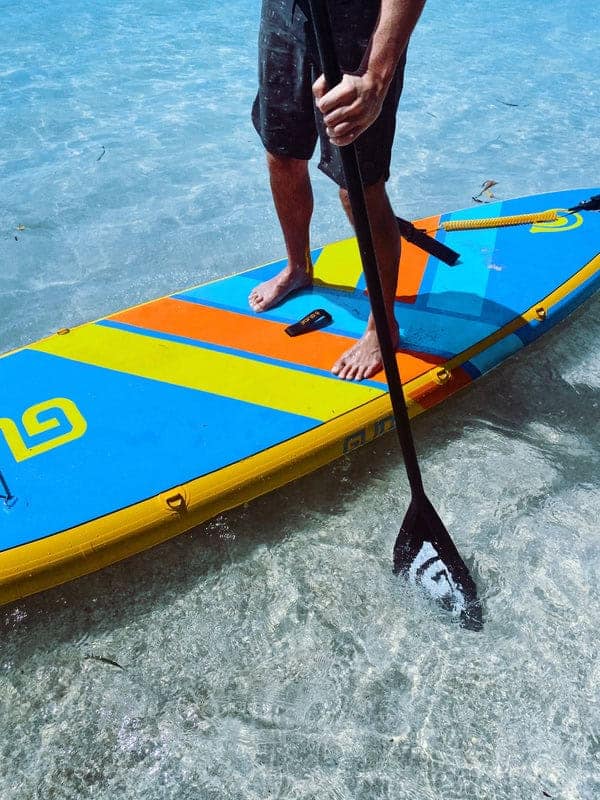How to Hold a Paddle Board Paddle?

When it comes to paddle boarding, one of the most important skills to master is how to hold a paddle board paddle correctly. Proper paddle grip, hand placement, and body positioning can greatly enhance your paddling experience and efficiency. In this article, I will guide you through the steps of how to hold a paddle board paddle correctly, common mistakes to avoid, tips for a proper paddle stroke, and how to adjust your paddle length for different activities.
Basic Grip
The first step in holding a paddle board paddle is to establish a basic grip. Start by holding the paddle with both hands, ensuring that your hands are shoulder-width apart. Your grip should be firm but not too tight, allowing for flexibility and control. Avoid gripping the paddle too tightly, as this can lead to muscle fatigue and discomfort during longer paddling sessions.
Hand Placement
Proper hand placement on the paddle is crucial for efficient paddling. Place one hand on the top of the paddle grip, with your fingers wrapped around the handle. This hand will act as your control hand, providing stability and control. The other hand should be placed on the shaft of the paddle, slightly below the control hand. This hand will act as your power hand, generating the force needed for each stroke.
Body Positioning
Maintaining the correct body positioning while paddling is essential for balance and stability. Stand with your feet shoulder-width apart, knees slightly bent, and your core engaged. Keep your back straight and your gaze forward, focusing on the direction you want to paddle. Avoid leaning too far forward or backward, as this can throw off your balance and make paddling more challenging.
Common Mistakes to Avoid

While learning how to hold a paddle board paddle, it’s important to be aware of common mistakes that can hinder your paddling experience. Here are a few mistakes to avoid:
Gripping Too Tightly
One common mistake is gripping the paddle too tightly. This can lead to muscle fatigue and discomfort, making it harder to maintain a steady paddling rhythm. Remember to keep your grip firm but relaxed, allowing for flexibility and control.
Incorrect Hand Placement
Another mistake to avoid is incorrect hand placement on the paddle. Placing your hands too close together or too far apart can affect your paddling efficiency. Make sure to position your hands shoulder-width apart, with one hand on the grip and the other hand on the shaft, slightly below the control hand.
Leaning Too Far Forward or Backward
Leaning too far forward or backward can throw off your balance and make paddling more challenging. It’s important to maintain a neutral body position, with your back straight and your gaze forward. This will help you stay balanced and paddle with ease.
Tips for a Proper Paddle Stroke

To maximize your paddling efficiency, here are some tips for a proper paddle stroke:
Engage Your Core
Engaging your core muscles is essential for generating power and stability during each stroke. Focus on using your abdominal muscles to rotate your torso and drive the paddle through the water.
Use Your Whole Body
Paddling is not just an arm workout; it’s a full-body exercise. Utilize your legs, hips, and torso to generate power and propel yourself forward. This will help you conserve energy and paddle for longer distances.
Keep Your Paddle Vertical
Maintaining a vertical paddle position throughout each stroke is crucial for efficient paddling. Avoid angling the paddle too far forward or backward, as this can create unnecessary drag and slow you down. Keep the paddle perpendicular to the water surface for maximum efficiency.
Reach Forward with Each Stroke
To maximize the reach and power of each stroke, make sure to reach forward with your top hand before initiating the stroke. This will allow you to fully engage your core and generate more power with each paddle stroke.
Adjusting Your Paddle Length
The length of your paddle will depend on the activity you are engaging in. Here are some guidelines for adjusting your paddle length:
Stand-up Paddle Boarding
For stand-up paddle boarding, the general rule of thumb is to choose a paddle that is 8-10 inches taller than your height. This will provide you with the optimal paddle length for efficient paddling and maneuverability.
Kayaking or Canoeing
When kayaking or canoeing, the paddle length will depend on the width of your boat. A wider boat will require a longer paddle, while a narrower boat will require a shorter paddle. It’s best to consult with a professional or refer to the manufacturer’s guidelines for the recommended paddle length for your specific boat.
Conclusion
Mastering the proper technique for holding a paddle board paddle is essential for an enjoyable and efficient paddling experience. By following the steps outlined in this article, avoiding common mistakes, and implementing the tips for a proper paddle stroke, you will be well on your way to becoming a skilled paddle boarder.
Remember to adjust your paddle length according to the activity you are engaging in, and always prioritize safety and comfort while on the water. Happy paddling!
FAQs
-
Which way do you hold a paddle board paddle?
Position your hands so that your elbows are at a 90 degree angle. With one hand on the top grip and that elbow at a 90 degree angle, slide the other hand along the shaft until it’s at a 90 degree angle too. The hand that grips the shaft should be the same as the side you’re paddling on.
-
Why are sup paddles angled?
Angles give you more power per stroke, conserving energy and increasing the distance you’re able to cover. Surfing is best with a 7-degree angle, all-around use sits well with 10 degrees, and racing thrives with 12 degrees. Though a paddle is important, you can’t just use it by itself.
-
What is the correct position for paddle board?
A good rule of thumb is to place your feet shoulder width apart on either side of the handle. For the most control very slightly angle your feet outward. Distribute your weight evenly and do your best not to grip your toes to the deck pad as this will cause you to lose your balance.

